Saving Vegetables Seeds: Tomatoes, Peppers, Peas and Beans

Make sure to like Living Green and Frugally on Facebook, Shop at Amazon to help support my site and explore our PINTEREST BOARDS for innovative ways you can become self-sufficient.
As gardeners become more invested in sustainable practices and self-sufficiency, saving seeds from their own crops has gained popularity. Not only does seed saving allow you to preserve heirloom varieties and save money, but it also helps develop plants that are well-adapted to your specific growing conditions. In this article, we’ll focus on saving seeds from four popular vegetables: tomatoes, peppers, peas, and beans. These vegetables are relatively easy to work with, making them ideal for both beginner and experienced gardeners.
Why Save Seeds?
Saving seeds is an ancient practice that offers numerous benefits:
- Cost Efficiency: By saving seeds, you reduce the need to buy new seeds each year.
- Preservation of Varieties: Especially with heirloom seeds, you can help preserve unique varieties that might not be available commercially.
- Adaptation: Seeds saved from plants that thrive in your garden are likely to perform better in the same environment next season.
- Self-Sufficiency: Seed saving is a step towards a more self-sufficient garden, reducing reliance on external sources.
General Guidelines for Seed Saving
Before diving into the specifics for each vegetable, here are some general tips:
- Select Healthy Plants: Only save seeds from the healthiest, most vigorous plants. This ensures that the next generation of plants will have the best start.
- Isolate Plants: To prevent cross-pollination, especially in plants like peppers and tomatoes, consider isolating different varieties. This helps maintain the purity of the seeds.
- Allow Seeds to Mature: Seeds must fully mature on the plant before they can be harvested. This usually means waiting until the fruit or pod is overripe.
Saving Tomato Seeds
Tomatoes are self-pollinating, making them one of the easiest vegetables to save seeds from.
- Choose the Best Fruits: Select fully ripe tomatoes from healthy plants. Heirloom varieties are particularly good candidates for seed saving.
- Extract the Seeds: Cut the tomato open and scoop out the seeds along with the surrounding gel into a container.
- Ferment the Seeds: Allow the seeds and gel to sit in the container at room temperature for 2-4 days. This fermentation process helps remove the gel and kills off any potential diseases.
- Rinse and Dry: After fermentation, rinse the seeds thoroughly under water. Spread them out on a paper towel or screen to dry completely, which may take several days.
- Store: Once dry, store the seeds in a cool, dry place in a labeled envelope or jar.
Saving Pepper Seeds
Like tomatoes, peppers are also self-pollinating, but cross-pollination can occur. To maintain the purity of your seeds, grow only one variety or use isolation techniques.
- Select Ripe Peppers: Choose fully ripe peppers that have turned their final color (red, orange, yellow, etc.).
- Harvest Seeds: Cut open the pepper and remove the seeds. Spread them out on a paper towel.
- Dry Thoroughly: Let the seeds dry completely in a warm, well-ventilated area. This can take up to a week or longer, depending on humidity levels.
- Store: Store the dried seeds in a labeled envelope or jar in a cool, dark place.
View this post on Instagram
Saving Pea Seeds
Peas are self-pollinating and rarely cross-pollinate, making them another excellent candidate for seed saving.
- Allow Pods to Mature: Leave the pea pods on the plant until they turn brown and dry. The seeds inside should rattle when shaken.
- Harvest the Pods: Pick the dry pods from the plant.
- Extract and Dry: Shell the peas and spread them out on a screen or paper towel to dry for a few days.
- Store: Store the dry pea seeds in a labeled container in a cool, dark place.
Saving Bean Seeds
Like peas, beans are self-pollinating and straightforward to save.
- Let Pods Mature: Allow the bean pods to remain on the plant until they are brown and dry. The beans inside should rattle.
- Harvest: Collect the dry pods from the plant.
- Shell and Dry: Remove the beans from the pods and let them dry further in a well-ventilated area.
- Store: Store the dried beans in a labeled container in a cool, dry place.
Storing Your Seeds
Proper storage is crucial for maintaining the viability of your seeds:
- Cool, Dark, and Dry: Seeds should be stored in a cool, dark, and dry place. Ideal storage conditions are in airtight containers kept in a refrigerator or a similar cool environment.
- Labeling: Always label your seeds with the type, variety, and date of harvest. This helps you keep track of the seeds and ensures you plant them within their viable period.
Testing Seed Viability
Before planting, you can test the viability of your seeds:
- Place Seeds in Water: Put a few seeds in a glass of water. Viable seeds will sink, while non-viable seeds will float.
- Germination Test: Place a few seeds between moist paper towels and keep them in a warm place. Check after a week to see if they sprout.
Conclusion
Saving seeds from tomatoes, peppers, peas, and beans is a rewarding practice that can lead to a more resilient and self-sufficient garden. By following the steps outlined above, you can ensure that your garden flourishes year after year with plants perfectly adapted to your growing conditions. Happy gardening!